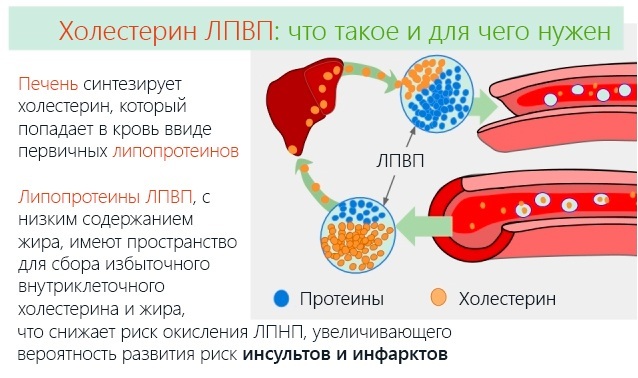Ascorbic acid possesses anti-inflammatory, bactericidal, immunostimulating properties. Uncontrolled intake of vitamin C can lead to an overdose, which is rare in adults, but is characterized by unpleasant symptoms and is accompanied by dangerous pathological conditions.
Record content:
-
1 Classification
- 1.1 Easy
- 1.2 Medium severity
- 1.3 Severe poisoning
-
2 Symptoms
- 2.1 Signs of drug intoxication
- 2.2 Specific symptoms
- 2.3 In elderly patients and pregnant women
- 3 Causes
-
4 Treatment methods
- 4.1 Polyphepan
- 4.2 Polysorb MP
- 4.3 Smecta
- 4.4 Regidron
- 5 Possible consequences and complications
- 6 Vitamin C overdose video
Classification
Ascorbic acid is a vitamin-like compound of a water-soluble type. It is not synthesized in the body, but it is of great physiological importance.
The daily norms of its consumption have been established for different categories of adult patients:
- men;
- women;
- pregnant women;
- the elderly;
- with chronic diseases of internal organs;
- athletes;
- smokers.
Ascorbic acid is a powerful antioxidant shield of organic structures. It is well absorbed and easily removed through the urinary tract.
An increased intake of vitamin C is recommended for the following pathological conditions:
- bacterial and fungal infections;
- seasonal ARVI;
- burn injuries;
- helminthiasis - a parasitic disease provoked by worms of the genus nematodes;
- irradiation with radioactive substances;
- alcoholic, chemical and drug intoxication;
- cholecystitis - inflammation of the gallbladder;
- violation of collagen synthesis;
- chronic liver dysfunctions;
- digestive disorders.
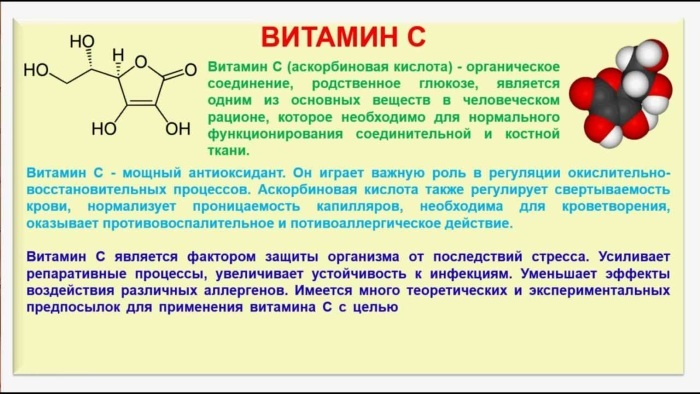
An overdose of vitamin C in adults has different symptoms. They depend on the stage, long-term intake of ultra-high doses and individual reactions of the body. Ascorbic acid is involved in metabolic, biochemical and metabolic processes. Vitamin C poisoning can lead to their violation.
Easy
The maximum daily intake of a water-soluble low molecular weight compound is set for adults at 30-50 mg. A slight excess of this volume leads to a mild form of drug intoxication.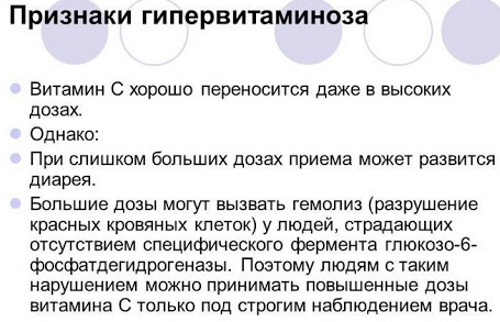
This stage is characterized by dyspeptic symptoms and nausea without activating the gag reflex. Digestive disorders of an organic nature may occur.
Violation of metabolic function is manifested by difficulties in deurination, a feeling of heaviness in the epigastric region. An easy stage of an overdose of ascorbic acid occurs with a systematic slight excess the following standards established for adult patients:
| Patient category | Recommended dose of vitamin C, mg / day |
| Women over 19 years old | 75 |
| Men 18-50 years old | 90 |
| Elderly | 100 |
| For colds | 500-600 |
| During the circulation of seasonal flu | 800-1000 |
| Pregnant | 300-400 |
| Athletes | 200-250 |
| Smokers | 1500 |
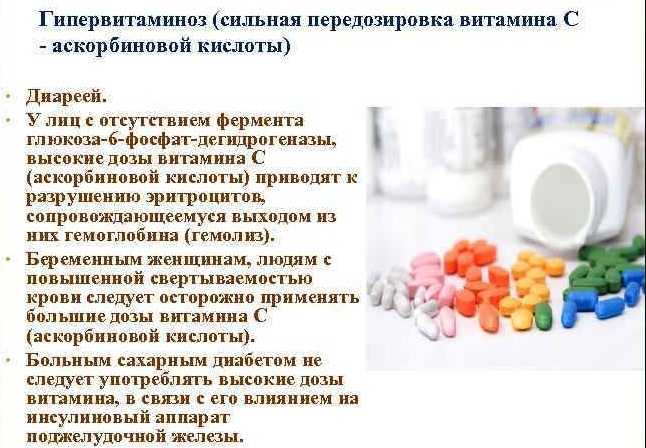
When taking vitamin food supplements and a diet saturated with ascorbic acid, it is undesirable to additionally use pharmaceutical preparations with this compound.
Medium severity
This pathological condition occurs when the recommended therapeutic dose is regularly exceeded by 2-5 times. This volume is fraught with impaired absorption of nutrients into the systemic circulation.
This clinical picture is observed when taking more than 2000 mg of vitamin C, which is at least weak, but still acid. There is a massive death of beneficial intestinal microflora.
This is manifested by increased pain in the epigastric region and stool disturbance. With moderate intoxication, diarrhea or constipation is possible. The immune system reacts to such a volume of physiologically active substance with allergic reactions in the form of urticaria and itching.
A single intake of 2000-2500 mg of vitamin C in adults usually does not lead to negative effects. The undigested excess of ascorbic acid is metabolized in the kidneys and eliminated through the urinary tract without pathological consequences.
Regular excess of the recommended dose by 2-5 times dramatically changes the situation. Vitamin C has weak cumulative properties. With a systematic intake in such volumes, its accumulation is observed in soft tissues and smooth muscle fibers.
Severe poisoning
The acute stage of drug intoxication with ascorbic acid occurs after exceeding the recommended daily dose by 10 times. It is expressed in jumps in blood pressure, cardiac arrhythmias, acute pain in the epigastric region.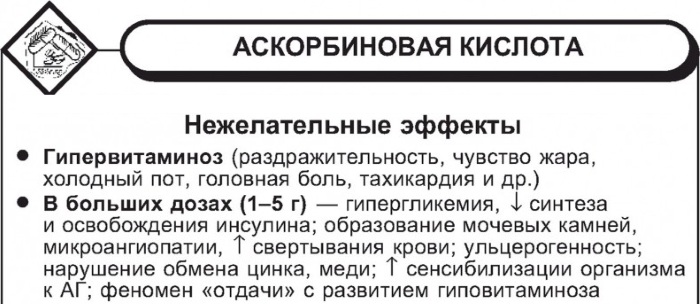
Vomiting with bloody discharge is possible. This condition poses an immediate threat to life and requires the use of a complex of resuscitation measures. Such situations are extremely rare in clinical practice.
An overdose of vitamin C (symptoms in adults with a severe form) alters the rheological properties of blood, increasing its fluidity and inhibiting coagulation. Any bleeding can be fatal.
Symptoms
External manifestations of hypervitaminosis C depend on the stage of the overdose. In most patients with severe poisoning, they become pronounced within 2 hours. after exceeding the permissible volume 10 times.
Signs of drug intoxication
Ascorbic acid is characterized by the standard signs of drug poisoning.
Among them:
- nausea;
- vomiting;
- cephalalgia of varying strength, duration and intensity;
- an allergic rash all over the body;
- itchy skin;
- hyperemia of the face;
- redness of the cornea of the eyes;
- angioedema;
- bloating of the abdomen;
- dizziness.
Many symptoms and external signs of overdose are due to the pharmacodynamic properties and the biological role of ascorbic acid. Due to its ability to change the rheological parameters of blood, blood pressure decreases.
Specific symptoms
Impaired coordination of movements and psychoemotional instability are considered clear signs of an overdose of ascorbic acid. Such symptoms are recorded in the acute stage.
With a systematic excess of the recommended daily volume of ascorbic acids develop pathological conditions, which are externally manifested:
- dry mucous membranes and skin;
- suppression of the functions of sweat, salivary and lacrimal glands due to violations of secretory activity and metabolic processes.
- increased acidity of gastric juice, expressed in heartburn and belching;

- unpleasant pulling sensations in the renal organ;
- irritation of the epithelium of the urinary tract, externally manifested by cystitis symptoms;
- rapid fatigue;
- a state of general weakness;
- decreased muscle tone;
- apathy.
Hypervitaminosis of a water-soluble compound is associated with exfoliation of the nail plates and hair columns, peeling of the outer layer of the epidermis.
Irritation of the mucous membrane of the gastrointestinal structures leads to the development of hyperacid gastritis. Some patients have impaired visual function. Ascorbic acid improves carbohydrate metabolism.
With its excessive use, its increased intensity is observed, which is expressed in a violation of the digestibility of food. The water-soluble biologically active compound strengthens the vascular walls and improves the permeability of small capillaries.
In elderly patients and pregnant women
In elderly patients and women, sleep dysfunction was recorded against the background of excessive use of ascorbic acid. The gastrointestinal tract reacts to the supply of a large volume of vitamin C with disturbed peristalsis and spasmodic pain.
An overdose of vitamin C leads to a loss of elasticity in the bloodstream. Their walls become pathologically fragile. These are life-threatening symptoms that are recorded in adults and elderly patients with systematic abuse of ascorbic acid.
Vitamin C is involved in the synthesis of protein hormones. Their increased production creates an additional burden on the heart. This symptom is especially dangerous for women during pregnancy, as it can cause cardiovascular disorders and complications of intrauterine development of the fetus.
Causes
Hypervitaminosis C is susceptible to patients who uncontrollably take pharmacy ascorbic acid for inflammatory diseases, during epidemiological outbreaks and for prophylactic purposes.
Among the causes of overdose, there is a combination of products saturated with this biologically active compound, with treatment with medicines, which include ascorbic acid.
In such conditions, the body does not have time to process and remove excess vitamin. With prolonged use, it accumulates in tissues, concentrates in hematological fluid and urinary sediment.
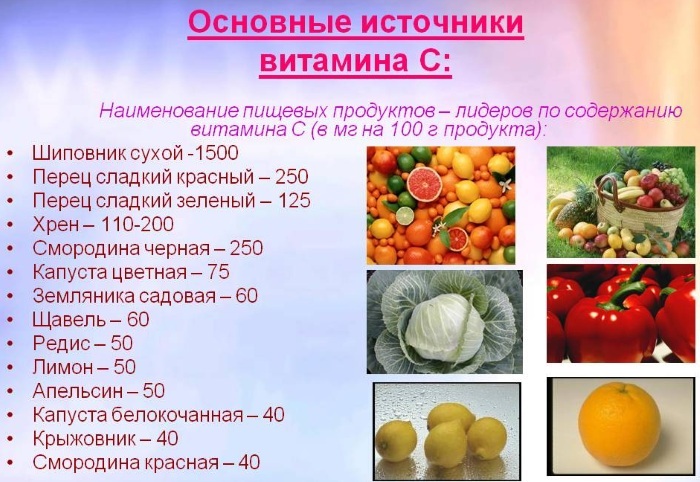
In practice, this situation is extremely rare, since ascorbic acid is one of the most easily assimilated substances. For an overdose, you need to eat at least 5 kg of parsley or white cabbage per day, reinforcing an extraordinary diet with large volumes of citrus fruits and medications.
Vitamin C in the form of injectable solutions is used in the complex treatment of certain infectious diseases and inflammatory processes, to strengthen the immune system.
When taking such drugs, the probability of an overdose is negligible. However, with the confluence of unfavorable circumstances and a frivolous attitude, the use of injectable drugs can become one of the factors of hypervitaminosis C.
Parenteral administration leads to overdose only with uncontrolled self-medication. Experts say the main cause of hypervitaminosis in adults is low awareness combined with self-confidence.
Treatment methods
With severe intoxication, the patient needs first aid. The stomach is washed with a warm solution of potassium permanganate (potassium permanganate). It is advisable to induce a gag reflex, if it is not activated spontaneously.
Vitamin C overdose symptoms in adults can be severe and life-threatening. The task of first aid is to reduce the severity of intoxication. The easiest way to trigger the gag reflex is to press with fingers or a spoon on the root of the tongue.
It is available at home and does not require medical qualifications. It should be borne in mind that the discharge of vomit with an overdose of vitamin C is sometimes accompanied by impaired respiratory activity.
Gastric lavage should not be used if the patient loses consciousness.
First aid rules for severe poisoning with ascorbic acid:
- The victim should be put to bed. With chills and hyperthermia, you can cover with a light blanket.
- With excessive nervous excitement, a sedative medicine with sedative properties is taken.
- Pulse activity and blood pressure are measured periodically. In case of hypertensive or hypotonic effects, a drug should be taken to stabilize blood pressure.
- For acute and spasmodic pain in the epigastric region, enterosorbent medications are used. Activated charcoal is suitable, which should be taken at the rate of 1 tablet for every 10 kg of body weight. Effectively cleanse the gastric cavity and intestinal lumen Polyphepan, Polysorb, Smecta. Enterosgel is intended to eliminate severe intoxication.
There is no specific antidote to ascorbic acid. The therapy is purely symptomatic. Below are the drugs used in acute vitamin C poisoning.
Polyphepan
Natural enterosorbent with non-specific detoxification properties. Available in dark brown amorphous powder, oral granules and flat-cylindrical tablets. The pharmacologically active component is hydrolytic lignin.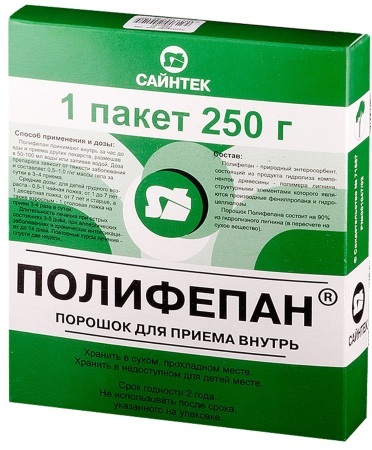
This product from the processing of hydrocellulose and phenylpropane has high absorption characteristics.
The substance in the lumen of the digestive system binds vitamin C and other toxic compounds, including:
- allergens;
- heavy metal salts;
- bacterial and chemical toxins;
- medicinal components;
Polyphepan absorbs an excess of certain metabolic and metabolic products - bilirubin and urea, which provoke endogenous toxicosis. In addition to hypervitaminosis C, the drug is effective in eliminating dysbiosis, dyspeptic symptoms, and food poisoning.
It is used in the treatment of inflammation with the release of purulent exudate, salmonellosis, dysentery. Polyphepan quickly removes xenobiotics from the body. Powder and granules are dissolved in 50-100 ml of water.
In case of vitamin C poisoning, the medicine is taken immediately after the detection of symptoms of an overdose at the rate of 1 g of active ingredient per kg of body weight. In case of chronic intoxication, a course application of up to 14 days is possible.
Polysorb MP
A drug that effectively removes toxins from the body. The pharmacological formula of Polysorb MP is based on silicon dioxide, known for its detoxifying properties. It is produced in the form of a finely dispersed white powder, intended for mixing with water and subsequent oral administration.
Indications for use:
- acute overdose of vitamin C;
- food poisoning;
- infectious diseases of the gastrointestinal tract;
- stool disorders;
- dyspepsia;
- intoxication with household chemicals;
- allergic reactions.
Polysorb MP is a part of complex drug therapy for disorders of the hepatobiliary system, renal failure, dysbiosis. The medicine should not be used in patients with peptic ulcer and an atonic state of the intestine.
To eliminate acute vitamin C intoxication, adults are prescribed 200 ml of suspension for a single dose. This amount of water is mixed with 1-2 tablespoons. medicinal powder.
Smecta
Absorbing antidiarrheal drug used in acute vitamin C poisoning. It is produced in the form of a powder composition for the preparation of a drinking suspension. Has a pleasant vanilla or orange flavor. The active substance is dioctahedral smectite.
Auxiliary components:
- sodium saccharinate;
- monohydrogenated dextrose;
- flavor enhancers - vanillin or orange essence;
- flavors.
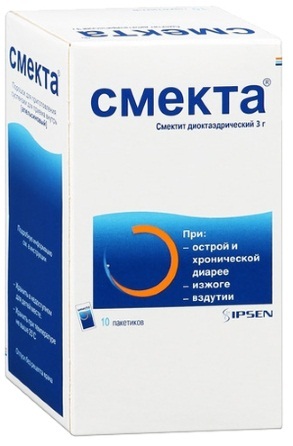 The pharmacologically active component is a combination of aluminum silicate with magnesium. The substance binds toxins and gases in the cavity of the gastrointestinal tract, ensuring their rapid excretion.
The pharmacologically active component is a combination of aluminum silicate with magnesium. The substance binds toxins and gases in the cavity of the gastrointestinal tract, ensuring their rapid excretion.
Dioctahedral smectite is a selective sorbent due to the stereometric structure of its molecules.
The drug has an increased enveloping ability, preventing the absorption of excess ascorbic acid into the systemic circulation.
It is important to take medication immediately after the onset of symptoms of acute intoxication. Smecta relieves irritation of the gastrointestinal mucosa caused by the action of vitamin C.
The active ingredient of the drug has a calming effect on muscarinic receptors and binds to mucin glycoproteins. The powder package is diluted with 100 ml of water.
Regidron
An overdose of vitamin C in adults often has symptoms in the form of rapid dehydration and loss of body fluids by tissues, which leads to their degenerative state.
To prevent such a negative effect, Regidron is used, an effective Finnish drug with detoxification and rehydration properties. The medicine, produced in the form of a powdery composition, contains substances with increased water-holding capacity - dextrose, sodium chloride and citrate.
They eliminate the state of metabolic acidosis caused by an overdose of vitamin C, bind toxins and heavy metal salts. The osmolarity of the prepared drinking suspension reaches 260 mosm / l.
The slightly alkaline solution has a pH of 8.2. It is considered an effective treatment for symptomatic treatment of ascorbic acid poisoning. Rehydron should not be used for renal dysfunctions, diabetes mellitus, intestinal obstruction.
Dilute the contents of a disposable bag with the drug in 1 liter of boiled water cooled to room temperature. To eliminate other symptoms of vitamin C overdose, antiarrhythmic and hypotonic medications are used. Prescribe hepatoprotectors and tissue regeneration stimulants.
Possible consequences and complications
Regular intake of ascorbic acid in volumes significantly exceeding the recommended ones is capable of cause carcinogenic effects, which are considered the main cause of the development of cancer hyperplasia.
The pancreas undergoes functional failures, which is fraught with pancreatitis and diabetes mellitus. Regular overdose of vitamin C causes urinary and urogenital disorders.
Among the possible complications and consequences are:
- chronic gastritis;
- intestinal perforation;
- stomach ulcer;
- systemic anaphylactic reactions;
- decrease in the concentration of leukocytes in the blood plasma.
For fertile women, there is a high risk of a difficult pregnancy. There are gynecological disorders, the adrenal glands atrophy, stones are formed in the urinary and gall bladders. Useful enterobacteria perish and the entire natural microbial flora of the body is disrupted.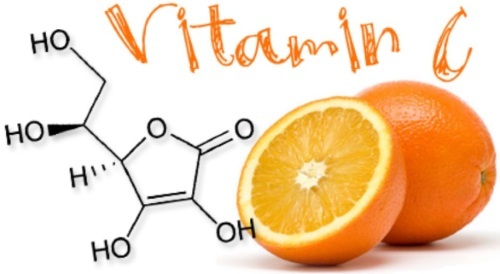
Regular overdose of vitamin C leads to the development of heart failure, a permanent increase in blood pressure. Such symptoms in adults often provoke heart attacks and strokes. The absorption of B vitamins is impaired and hormonal disorders occur.
Vitamin C overdose video
What if you overdose on vitamin C:


